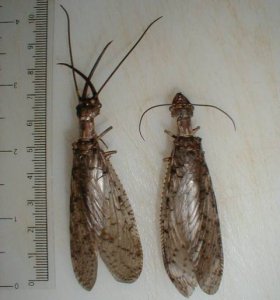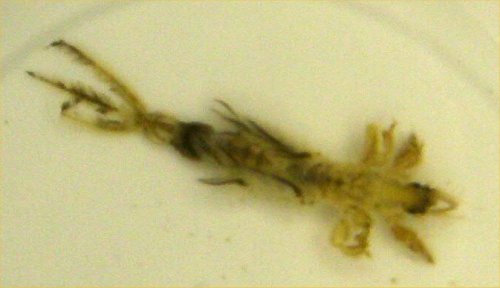 |
 |
|
|
Last Updated: 9/26/16

On This Page:
Alderflies, Dobsonflies, and Fishflies (Megaloptera)
Caddisflies (Trichoptera)
Mayflies
Spongilla flies
Springtails
Stoneflies
On Other Pages:
Aquatic Beetles - Water Beetles, Waterlily Leaf Beetles, Predaceous Diving
Beetles, Whirligig Beetles
Aquatic Moth Larvae
Aquatic Flies - Black Flies, Crane Flies, Dixa Midges, Drone Flies, Horse Flies,
Phantom Crane Flies, Phantom Gnats, Sand Flies, Soldier Flies, True Midges
Aquatic True Bugs - Backswimmers, Broad-Shouldered Water Striders, Creeping
Water Bugs, Giant Water Bugs, Marsh Treaders, Pygmy Backswimmers, Water Boatmen, Water Scorpions,
Water Striders, Water Treaders, Toad and Shore Bugs
Dragonflies and Damselflies - (Odonata)
Mosquitoes
Megaloptera include alderflies, Dobsonflies, and fishflies. These larvae are all predators. Their appendages are small but there are a LOT of them. Most are nocturnal.
Alderflies
Alderfly larvae have thick brown skin, grow to about an inch long, have a single pointy tail, and tend to hide out.
Dobsonflies

Here are two photos of a female dobsonfly that Ken sent me on 6/21/04. In the second photo,
she is threatening him!:
Dobsonfly
Dobsonfly
Dobsonfly larvae are called hellgrammites (they look like they are from hell?) and grow up to 3 inches long. The adults grow up to 2.7 inches, and the male has inch-long curved mandibles. Adult males have jaws half the length of their body. Females' jaws are smaller but can bite. Hellgrammites live for up to 2 or 3 years in the water while the adults live only a few days. Hellgrammites are often used for bait. The larvae use their killer jaws to capture and eat insects and small animals. The Eastern Dobsonfly is Corydalus cornutus.
Kelly from "The Black River Action Team" sent these photos of dobsonflies on 6/20/12.
Thanks!
A male adult dobsonfly
Hellgrammite - pupal form.
Drawings of a larval Dobson fly can be seen at this water bug site under hellgrammite.
Drawings of a larval and adult dobson fly can be seen at this site. Note that this is an archived version of the site as it no longer exists.
Fishflies
Fishfly larvae, Chauloides species, look like Dobson fly larvae, but only grow to about an inch long. Larvae eat aquatic insects by seizing them in their jaws. Nocturnal adults look like a cross between a cicada and a moth. They are poor flyers and easy to catch.
Caddisflies, or Trichoptera, are some of the most common species you will find in your pond. Turn over a rock in your waterfall or stream. If there are worm-like critters wiggling about or creatures inside little homes made of rock and debris, they are caddisflies. Caddisfly adults are about 0.5 inches long while larvae are 0.6 to 1.5 inches long. They use two tail hooks to anchor to their homes of leaves, sand, twigs, and other debris. They eat plants and animals that pass by in streams as well as moss and algae, depending on the species. After being a larvae for quite a time, they change into pupae for about two weeks and then adults for a month. The nocturnal adults look like moths. There are 750+ North American species. Each species has a differing physical characteristic and makes their portable home slightly differently. A few species do not make homes and are free-living. Homes can look like a bunch of twigs, a cocoon, a tunnel of sand, a cornucopia, or many other designs.
Cheryl informed me that caddisflies are the only aquatic insect to spin silk. They use it to make little webs to trap detritus and for cocoons.
One caddisfly is Betten's silverstreak caddisfly, Grammotaulius bettenii. It grows from a quarter of an inch to almost an inch. Larvae eat algae and debris. Their tubes are made of dead leaves and twigs and saliva.
I was sent some strange, donut-shaped egg masses with green eggs (because algae grows on them) back in 2007. In late 2014, someone asked me about similar egg masses, and they were able to do research and determine that the eggs are probably caddisfly eggs. To see photos and learn how this was figured out, see the bottom of my main insect page.
On 7/27/16, Elizabeth in New Hampshire sent his photo for identification. It looks similar to the caddisfly
eggs at the bottom of my main insect page as well as others that I have seen.
Caddisfly eggs
Drawings of a larval and adult caddisfly can be seen at this water bug site.
Drawings of a larval and adult caddisfly can be seen at this site. Note that this is an archived version of the site as it no longer exists.

Ephemeroptera, or mayflies, are very common. About 500 species occur in North America alone. Mayflies are a vital source of food for higher animals, including your pet fish. They range from 0.8 inches for the smaller species to 2.5 inches for the biggest species with larvae being slightly smaller than adults. Most ponds have them in the bottom mulm or sludge. When I clean my bags of bioballs, they crawl out in an attempt to find water again. They can be discerned from stoneflies and other insects by their three tails which vary in length and adornment with species. Adults have four see-through wings held aloft while resting. Three (or rarely two) long filaments extend from their abdomen in both larvae and adults. Larvae are called naiads and have rows of leaflike gills down the sides of their bodies (usually seven pairs of gills). They eat small plants, animals, and debris for the two months to three years that they spend in the water (varies with species).
When the larvae are ready to leave the water, they pop to the surface, shed their skin, and fly off. You may find their shed skins or exoskeletons around the pond edges. After a few days dully-colored (called a dun or subimago), they again shed to become a shiny, breeding adult (called a spinner or imago). They are called Ephemeroptera because the mature adults are ephemeral, meaning they die after just a few hours (but not before they breed, and females lay eggs in water). Since they live so short a time as adults, their mouths are non-functional, and adults do not eat. Sometimes a swarm of millions of adults will mate in flight.
Some types of mayflies include hexagenias (largest in North America), isonychia (dart about in fast water), cloeon (climbs around plants), ephemerella (common, big gills, clings to things), ephemera (live in sediment, move gills to get oxygen in the borrow), and blasturus (in early spring, dart around).
Photos:
These photos are from 5/4/11 when I removed the woodfrog tadpoles from the 50 gallon
Mayfly in my 1800 gallon pond on
3/25/07.
Mayfly - the original photo from which the
above photo was cropped to give you a sense of scale. I made an area to point to the tiny
mayfly.
A burrowing mayfly larvae photo courtesy of Kelly and "The Black River Action Team." The species is Hexagenia limbata. She sent insect photos on 6/20/12. Thanks!
Drawings of a larval and an adult mayfly can be seen at this water bug site.
Neuroptera or spongilla flies are small and active larvae with bristles on their body. They eat freshwater sponges (thus "spong"illa). The six or so species in North America are not well studied at all.
Collembola are common in the spring in ponds. They are tiny and bounce all over the pond surface. They are often white but can also be black, orange, yellow, red, or even blue. They do no harm and small animals may eat them. Less than 0.2 inches long, they use a forked tail to spring about. They do not enter the water. They can occur any place that has some moisture.
Springtails are sometimes mistaken for aphids but springtails are smaller. They often occur in large groups and seem to appear out of nowhere. They are not a threat to the pond animals. Various species may eat pollen, bacteria, mold, decaying plants, and/or algae.
Links on springtails:
Sprintails on What's That Bug Site
Wikipedia page on Springtails
Ohio State University Fact Sheet on Springtails. Note that this is an archived version of the
site which no longer exists.
Judith took a photo of a Western tadpole in May of 2010 and captured a springtail in the
photo.
Tadpole and springtail
Plecoptera, or stoneflies, are indicative of good water quality. They are similar in appearance to mayflies but generally larger and with only two tails. About 300 species can be found in North America. Nymphs prefer flowing water. Growing from 0.8 to 2 inches, they have tufts of gills under their legs (like arm pit hair). Some species eat animals while others eat plants. They look like aliens to me.
An adult stonefly courtesy of Kelly and "The Black River Action Team." She sent insect photos on 6/20/12. Thanks!
Vince in the UK sent this photo on 9/18/16 that I believe to be some species of stonefly that has just left the water.
As such, the wings are not yet evident but the insect also does not look like the larvae. Correct me if I am wrong
as I am not an entomologist!
Green stonefly
1
|
|
Return to the main insect page.
See the master index for the insect pages.

|

|
E-mail RobynCopyright © 1997-2025 Robyn Rhudy |

|
 |